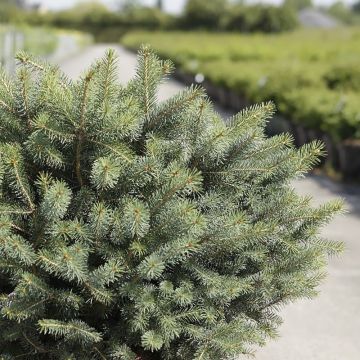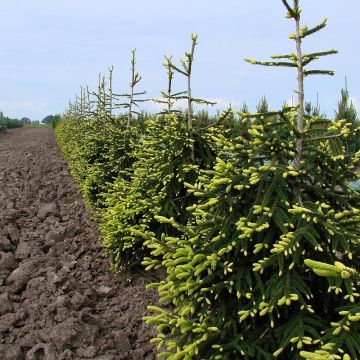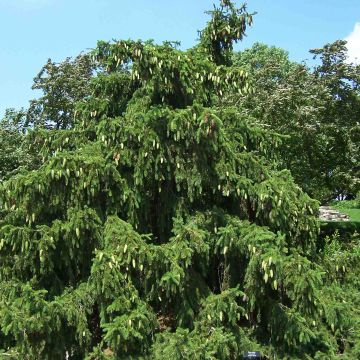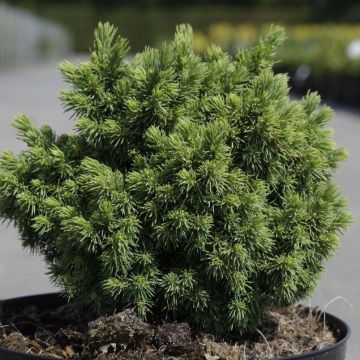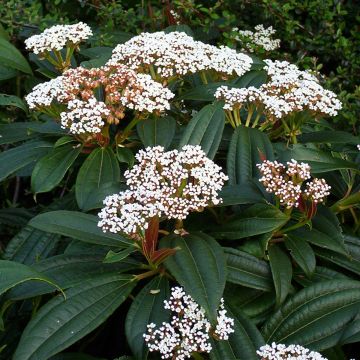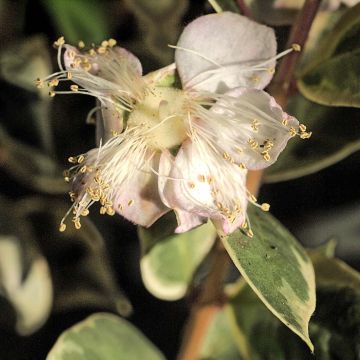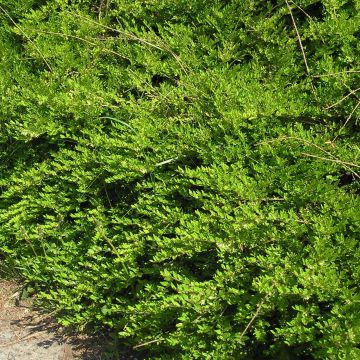

Picea mariana Aurea - Epinette noire
Picea mariana Aurea - Black Spruce
Picea mariana Aurea
Black Spruce, Swamp Spruce, Bog Spruce
This plant carries a 24 months recovery warranty
More information
We guarantee the quality of our plants for a full growing cycle, and will replace at our expense any plant that fails to recover under normal climatic and planting conditions.
From €5.90 for pickup delivery and €6.90 for home delivery
Express home delivery from €8.90.
Does this plant fit my garden?
Set up your Plantfit profile →
Description
Picea mariana 'Aurea' is a variety of black spruce that stands out for its narrow pyramidal habit and golden foliage. It produces thin branches covered with fairly short and dense needles, which become trailing over time. Its slender silhouette is accompanied by bright foliage, with short needles of a distinctly golden hue in spring, becoming more bluish but still retaining a beautiful golden reflection in winter. Slow-growing, it is perfectly suited to small gardens where it works wonders in borders or as a standalone plant. It is a low-maintenance and adaptable evergreen conifer, appreciating well-drained, moist to dry, non-calcareous soils and a sunny exposure.
Picea mariana, also known as Black Spruce or Canadian Spruce, is an evergreen conifer belonging to the Pinaceae family, native to the northeastern United States, Canada, and dominating the forests of Alaska. In its natural environment, the taiga, which is often very harsh, it grows slowly, with a habit that can vary depending on its habitat, but is usually pyramidal and dense, with a broad base. In challenging conditions, it will be bushy and compact, while in favourable conditions, it will form a slender tree. This tree can reach a height of 20m (66ft). This conifer is a symbol of the boreal forest of America, growing up to the edge of the tundra.
The 'Aurea' variety, derived from this species, is a dwarf form and particularly bright, with a compact, conical, and narrow habit. Its growth is slow. After 10 years, it will reach approximately 2m (7ft) in height and 1m (3ft) in width, sometimes more in cool and humid climates. Eventually, it can reach a height of 9m (29ft) with a base width of 3 to 4m (10 to 13ft). It produces thin branches arranged in regular spirals, which become trailing with age. They are covered with narrow, pointed, densely arranged, and aromatic (resinous smell) needles that are 6 to 12mm (0.2 to 0.5in) long. They are covered with a white wax. Its young spring shoots are distinctly golden yellow, then its foliage takes on a uniformly bluish-green colour with golden reflections. This conifer produces small cones, resembling those of larches. They measure 2 to 3.5cm (1in) in length and are purple when young, turning pale brown at maturity.
With its bright foliage, moderate growth, undemanding nature, and ease of cultivation, it is ideal for small gardens, both in borders and as a standalone plant. It thrives in many situations, as long as the soil is well-drained and free of limestone. It can be combined with prostrate (Juniperus horizontalis 'Blue Chip'), globose (Picea glauca 'Alberta Globe'), columnar, or upright dwarf conifers. Since this black spruce prefers acidic soils (even peaty ones), it can be mixed with rhododendrons, camellias, pieris, and andromedas. The structural qualities of conifers naturally stand out in the design of a contemporary garden but can also be incorporated into more traditional gardens and serve as a focal point throughout the year.
Report an error about the product description
Picea mariana Aurea - Black Spruce in pictures
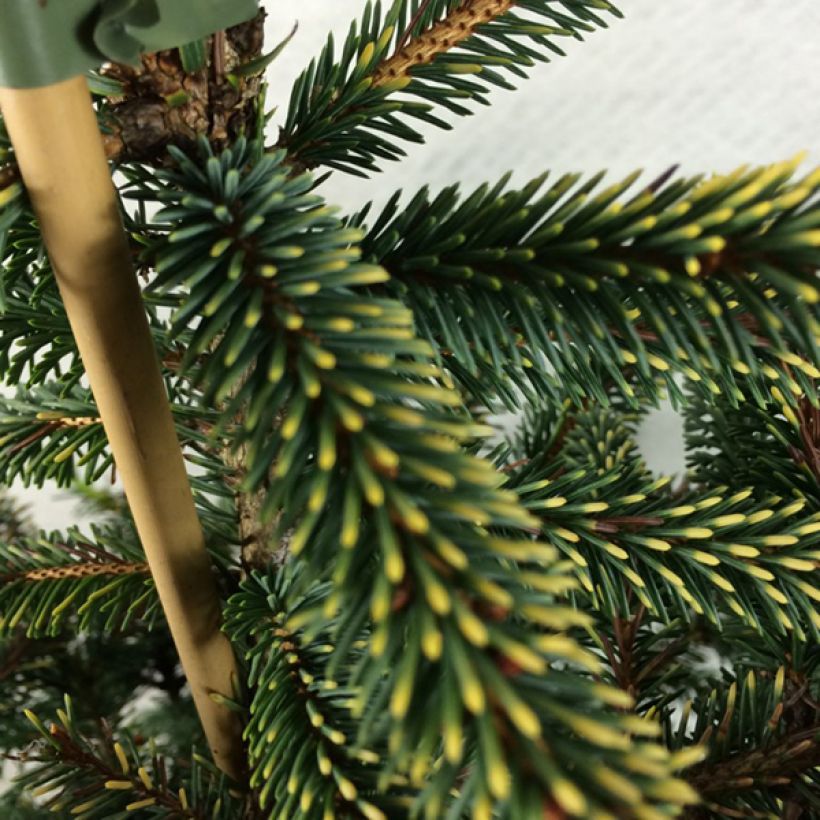



Plant habit
Flowering
Foliage
Botanical data
Picea
mariana
Aurea
Pinaceae
Black Spruce, Swamp Spruce, Bog Spruce
Cultivar or hybrid
Other Picea
Planting and care
Plant from September to November and from February to June in deep, well-drained, light, preferably neutral to acidic, and moist to dry soil. Peaty, sandy, loamy, or rocky non-calcareous soil is perfectly suitable. Choose a sunny or semi-shaded location, sheltered from prevailing winds. In overly sunny and dry conditions, it will be more susceptible to red spider mite attacks. Soak the root balls well before planting. Apply organic matter during planting and water generously in the first few years, especially during prolonged drought. Apply a special conifer fertiliser every year in April and weed the soil in summer. This exceptionally hardy conifer (down to at least -50°C (-58°F)) does, however, fear heavy, waterlogged soils in winter. Pruning is not necessary, as this conical plant reveals its full potential when allowed to grow freely.
Planting period
Intended location
Care
This item has not been reviewed yet - be the first to leave a review about it.
Evergreen shrubs
Haven't found what you were looking for?
Hardiness is the lowest winter temperature a plant can endure without suffering serious damage or even dying. However, hardiness is affected by location (a sheltered area, such as a patio), protection (winter cover) and soil type (hardiness is improved by well-drained soil).

Photo Sharing Terms & Conditions
In order to encourage gardeners to interact and share their experiences, Promesse de fleurs offers various media enabling content to be uploaded onto its Site - in particular via the ‘Photo sharing’ module.
The User agrees to refrain from:
- Posting any content that is illegal, prejudicial, insulting, racist, inciteful to hatred, revisionist, contrary to public decency, that infringes on privacy or on the privacy rights of third parties, in particular the publicity rights of persons and goods, intellectual property rights, or the right to privacy.
- Submitting content on behalf of a third party;
- Impersonate the identity of a third party and/or publish any personal information about a third party;
In general, the User undertakes to refrain from any unethical behaviour.
All Content (in particular text, comments, files, images, photos, videos, creative works, etc.), which may be subject to property or intellectual property rights, image or other private rights, shall remain the property of the User, subject to the limited rights granted by the terms of the licence granted by Promesse de fleurs as stated below. Users are at liberty to publish or not to publish such Content on the Site, notably via the ‘Photo Sharing’ facility, and accept that this Content shall be made public and freely accessible, notably on the Internet.
Users further acknowledge, undertake to have ,and guarantee that they hold all necessary rights and permissions to publish such material on the Site, in particular with regard to the legislation in force pertaining to any privacy, property, intellectual property, image, or contractual rights, or rights of any other nature. By publishing such Content on the Site, Users acknowledge accepting full liability as publishers of the Content within the meaning of the law, and grant Promesse de fleurs, free of charge, an inclusive, worldwide licence for the said Content for the entire duration of its publication, including all reproduction, representation, up/downloading, displaying, performing, transmission, and storage rights.
Users also grant permission for their name to be linked to the Content and accept that this link may not always be made available.
By engaging in posting material, Users consent to their Content becoming automatically accessible on the Internet, in particular on other sites and/or blogs and/or web pages of the Promesse de fleurs site, including in particular social pages and the Promesse de fleurs catalogue.
Users may secure the removal of entrusted content free of charge by issuing a simple request via our contact form.
The flowering period indicated on our website applies to countries and regions located in USDA zone 8 (France, the United Kingdom, Ireland, the Netherlands, etc.)
It will vary according to where you live:
- In zones 9 to 10 (Italy, Spain, Greece, etc.), flowering will occur about 2 to 4 weeks earlier.
- In zones 6 to 7 (Germany, Poland, Slovenia, and lower mountainous regions), flowering will be delayed by 2 to 3 weeks.
- In zone 5 (Central Europe, Scandinavia), blooming will be delayed by 3 to 5 weeks.
In temperate climates, pruning of spring-flowering shrubs (forsythia, spireas, etc.) should be done just after flowering.
Pruning of summer-flowering shrubs (Indian Lilac, Perovskia, etc.) can be done in winter or spring.
In cold regions as well as with frost-sensitive plants, avoid pruning too early when severe frosts may still occur.
The planting period indicated on our website applies to countries and regions located in USDA zone 8 (France, United Kingdom, Ireland, Netherlands).
It will vary according to where you live:
- In Mediterranean zones (Marseille, Madrid, Milan, etc.), autumn and winter are the best planting periods.
- In continental zones (Strasbourg, Munich, Vienna, etc.), delay planting by 2 to 3 weeks in spring and bring it forward by 2 to 4 weeks in autumn.
- In mountainous regions (the Alps, Pyrenees, Carpathians, etc.), it is best to plant in late spring (May-June) or late summer (August-September).
The harvesting period indicated on our website applies to countries and regions in USDA zone 8 (France, England, Ireland, the Netherlands).
In colder areas (Scandinavia, Poland, Austria...) fruit and vegetable harvests are likely to be delayed by 3-4 weeks.
In warmer areas (Italy, Spain, Greece, etc.), harvesting will probably take place earlier, depending on weather conditions.
The sowing periods indicated on our website apply to countries and regions within USDA Zone 8 (France, UK, Ireland, Netherlands).
In colder areas (Scandinavia, Poland, Austria...), delay any outdoor sowing by 3-4 weeks, or sow under glass.
In warmer climes (Italy, Spain, Greece, etc.), bring outdoor sowing forward by a few weeks.

































